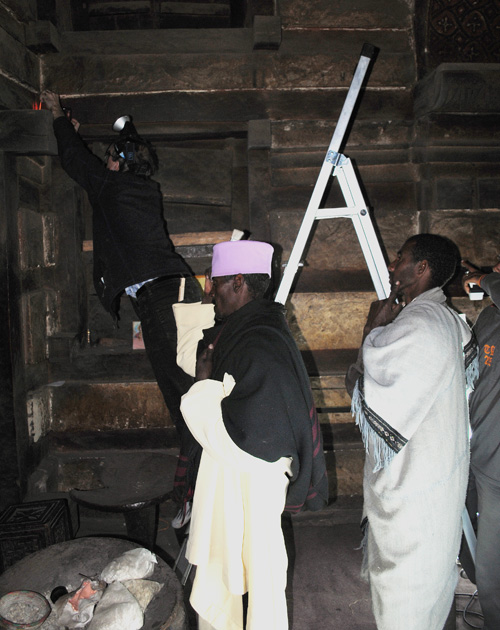_______________________________________________________________________________
Axonometric drawing of the church facing south-east by Tadesse Girmay. SCECH ©
Ocular and technical examination of church and palace
An overall examination of walls, ceilings and arches was done in order to achieve a general picture of the extant of decay as well as a building inventory of the state of the church and the palace. This included photographic documentation and a close reading considering:
* Structural stability of the building constructions and used material
* Strength and porosity of walls- and roof surfaces
Building engineer Karl-Gunnar Olsson examine the eastern wall of the southern aisle in company
with Abba Welde Qirqos and other priests and one of the villagers. SCECH ©
* Condition of plaster- and painted surfaces, occurring cracks and decolouration
* Microbiological changes and changes due to noxious animals
* Deterioration caused by pollution, mould or salt
The nave facing west. The beautiful interior with all its architectural details are covered with a thick
layer of dust collected during nine centuries. SCECH ©
* Soiling due to dust, dirt or/and soot coming from wax candles and incense
* The general impression of damages from aesthetical point of view in present state
Taking of random samples for technical analysis
Taking of random samples are essential in the preparatory work for a conservation and constitute an important part of the research that belongs to these kind of projects. Responsible for this part of the examination was the restorer and expert on multispectral analysis in connection to painting conservation Peder Boellingtoft.
Plaster
In order to receive information on the make-up of plaster, the degree of decay as well as possible salt content a plaster sample was taken in the nave.
Color pigments and its bonding agents
The above-mentioned taking of plaster sample as well as of random samples of used pigments in the church was conducted by Peder Boellingtoft.
Surface with marked places with red points for the random samples of paint. Eastern wall between
the the west and middle arch in the nave. SCECH ©
All-in-all 10 small samples of pigment, 2-4 square mm (micro cuttings), was done on the murals in the northern aisle as well as on the decorative painting on wood in the nave in order to find out the type of pigments used and its binder.
The restorer Peder Boellingtoft conduct one of the a micro cuttings on paint in the nave. SCECH ©
Mortar
A small quantity of mortar was taken in order to find out condition and composite. This and the below mentioned samples was taken by the civil engineer and building expert Karl-Gunnar Olsson who also is responsible for the climate measuring in progress.
Stone
A few small pieces of the stone belonging to the building construction was taken in order to establish which kind of stone has been used as well as its condition.
Water
A small sample of moist soil material from the ground under the church in order to analyse possible salt content or other pullotion in direct connection to the church was taken in order to receive information. Karl-Gunnar Olsson is also by assistance of one of the locals in YK conducting a long-term statistical investigation of collected water from local rain close to the cave and the buildings.
Climate measuring
A first measuring by five computerized climate measuring instruments placed on strategic locations inside and outside the buildings are since August 2012 collecting data about temperature and atmospheric humidity every 15th minutes and will continue until March 2013.
One of the climate measuring instruments placed outside on the south wall of the church. SCECH ©
________________________________________________________________________________
Link to next part:
Cleaning tests and measurements






Lämna ett svar
Du måste vara inloggad för att publicera en kommentar.